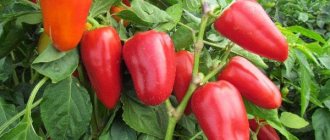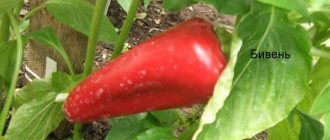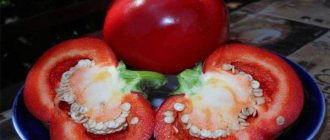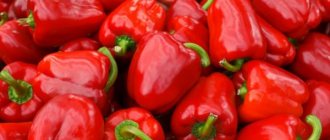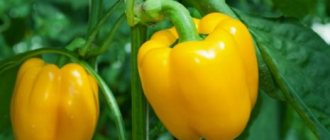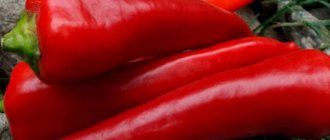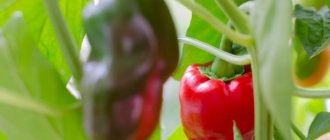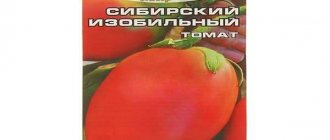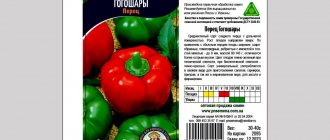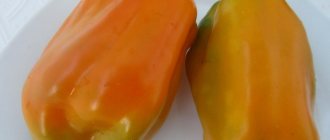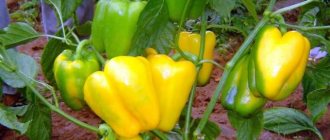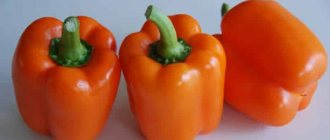Description of the variety, characteristics of the plant and its fruits
A sweet pepper with a “speaking” name was developed by Siberian specialists. In 2015, the variety was included in the State Breeding Register. The rights to produce seeds are owned by the SibSad trademark. Pepper is approved for planting in film-type greenhouses and open ground on all lands suitable for cultivation in the country.
This pepper has beautiful, large and slightly elongated fruits (see photo). The width of one specimen is about 10-12 cm. They have a glossy surface and 3-4 pronounced ribs. The thickness of the fleshy wall reaches 8-10 mm.
At technical maturity, peppers have a dark green color. When fully ripe they turn red. The fruits grow drooping. The culture is quite strong and high. The leaves are light and medium in size.
| Type of growth, bush height | Semi-standard, up to 80 cm |
| Ripe fruit color | Dark red |
| Planting scheme | 40x60 cm |
| Weight, length and shape of the fruit | Up to 450 g, 12-18 cm, cuboid |
| Ripening period, yield | Mid-season (125-130 days). In a greenhouse - up to 10 kg/m2. In exhaust gas - 5-7 kg/m2 |
| Drop off point | exhaust gas/greenhouse/greenhouse |
| Diseases | No data |
| By type of use | Universal |
| Flowering type | Female |
Mid-season peppers of Siberian selection
The varieties will delight you with high yields
The ripening period for medium varieties is about 130-145 days. Mid-season peppers are thick-walled and have high yields. Siberian breeders have developed a number of mid-season varieties with high quality indicators.
Highlight
The highlight is bell peppers with an average period of fruit ripening. The fruits begin to ripen 130-140 days from the moment the seeds are sown for seedlings. They are suitable for growing in open ground in Siberia and other regions.
The variety is resistant to various diseases, well adapted to low temperatures and lack of lighting.
Bush
Standard type bush. Height - 55-70 cm. The bush is medium-branched, which makes it compact and does not require tying or shaping. Each plant produces 8-12 peppers.
Fruit
The fruits of the plant have a number of characteristics:
- cylindrical shape;
- surface glossy, smooth;
- weight 160-180 g;
- walls 7-9 mm;
- color is rich yellow.
The fruits have a pleasant taste and rich aroma, which is preserved even after heat treatment.
Bagheera
This is a high-yielding mid-season variety with large fruits. Bagheera peppers begin to ripen 140-145 days from the date of sowing seeds for seedlings.
The crop is grown by seedling method. So that the peppers have time to ripen in open ground, the seeds are sown on the 10th of February.
Bush
The bushes are semi-spreading, low-growing, up to 55 cm high. The leaves are oval-pointed, green, and medium in size. On the bushes, 6-8 drooping fruits are formed during the season.
Fruit
The fruits are characterized by a number of characteristics:
- cubic shape, four-chamber;
- the surface is smooth, shiny;
- the walls are thick, up to 0.9 cm;
- weight up to 320 g;
- color from violet-black to red.
Their pulp is very juicy and aromatic. At the stage of technical maturity, the taste has a slight spicy note; the fully ripened fruit is sweet and very pleasant to the taste.
Taste properties, advantages and disadvantages of vegetables
According to the originator, the taste characteristics of the Siberian format are at a high level. The aroma is moderate and pleasant. The taste and characteristics of the fruits allow them to be used for any culinary task and preparation for the winter.
Other positive qualities of bell pepper:
- Excellent yield indicators. During the season, one bush produces up to 15 cubes of fruit.
- Large fruit. The average weight of peppers ranges around 200 g.
- Meatiness. Juicy and thick walls have a positive effect on taste.
- The presentation of the crop is the same as that of modern hybrids. Pepper is stored for a long time and is ready for transportation.
- Compactness of the plant. The bushes do not tend to grow to the sides.
- Availability for propagation by seeds. There is enough seed material inside the fruit to collect and store for the next season.
Pepper also has disadvantages:
- the variety is demanding on soil nutrition, watering, and sunlight;
- the crop is not recommended for industrial cultivation.
The best crops for the Moscow region
The best varieties of peppers for the Moscow region. If you are going to grow sweet peppers in the climate of the Moscow region, you can opt for the following varieties of pepper:
- Fidelio. The ripening process occurs within 90 days from the moment of the first shoots. The fruits are quite large. The variety is considered productive.
- Orange miracle. This variety can please the gardener with its high yield and large fruits. The weight of one fruit will be 250 grams.
- Semenya Agapovsky. The variety has excellent taste. These sweet fruits can be a good decoration for any holiday dinner.
- Atlantic. This fruit can be grown both in a greenhouse and in open areas. The plant is able to quickly and persistently resist viruses, diseases, parasites, as well as low temperatures outside.
Having learned all the intricacies of growing and caring for peppers and choosing the most suitable variety, very soon you will be able to reap a rich harvest of juicy fruits.
Features of agricultural technology: expert opinion
It takes a little more than 2 months to prepare seedlings grown from scratch for transfer to the garden bed. This period includes 10-14 days for seed germination after sowing. For 1 sq. m plot you can place up to 5 bushes. The plant responds well to mineral fertilizing and timely watering.
Advice. To achieve maximum productivity, collect fruits at the stage of technical ripeness.
Sowing seeds for seedlings | Planting seedlings in a greenhouse/greenhouse | Planting seedlings in exhaust gas | Stepsoning | Harvesting (in the greenhouse/in the greenhouse) |
| March | Mid May | June | Lower leaves and shoots | End of July/August |
| *dates are indicated for central Russia | ||||
Features of growing peppers, planting and care
We recommend sowing seeds for seedlings 70-75 days before the intended planting of plants in a permanent place. The optimal temperature for seed germination is 26-28°C.
You can see how to sow seeds for seedlings visually in the article correct seedlings of pepper.
When true leaves appear on the plants, they are transplanted into separate cups with a capacity of 0.3-0.5 liters.
Pepper does not like transplanting, so do not be surprised if after you have transplanted the seedlings into separate containers, they stop growing for a while. You can “smooth out” the stressful state a little by spraying the plants with Epin.
When to plant pepper seedlings in the ground
After the threat of return frosts has passed, the seedlings can be planted in a permanent location. Some people plant in open ground in May, while others only plant under covering material or under film; it all depends on the climatic conditions of your region.
When planting pepper seedlings in the ground for 1 sq. It is recommended to place up to 4 plants per meter of land, no more. Peppers are planted in the ground without being buried, but in exactly the same way as they grew in cups. Pepper plants, unlike tomatoes, very rarely produce lateral roots, so there is no point in deepening them.
Pepper responds well to watering and fertilizing with complex mineral fertilizers. During the summer, 2-3 feedings are usually done.
The Siberian Format pepper variety was included in the State Standard in 2015. register for the Russian Federation for cultivation in open ground and under film covers on private farms.
Reviews from ordinary gardeners
Irina from Tolyatti showed in the photo the results of her work on growing Siberian format sweet peppers. Her fruits turned out to be large, embossed, and beautiful. The weight of individual samples reached 350 g. Zulfiya from Ufa, in her review, praised the pepper for its high yield, excellent taste and thickness.
Nadezhda from Belarus also noted the productivity and large-fruitedness. And Svetlana (Perm region) classified the last characteristic as a minus. The peppers turned out to be inconvenient for stuffing.
The Siberian format is a relatively new sweet pepper with decent qualities. Declared key valuable properties: fertility, taste, presentation. Most of the advantages have been confirmed by ordinary farmers.
Characteristics and useful properties
Pepper contains a large number of useful microelements. It is considered a real storehouse of useful substances. Here are some of them:
- Vitamin C, which is considered to protect the entire body from stress and difficulties, improves the functioning of the body as a whole, helps to better absorb calcium and iron elements.
- Vitamin A, which can improve and normalize human immunity, improves vision and balances the functioning of the entire body.
- Vitamin PP is considered a medicinal product. Such a substance is extremely difficult to find in products of natural origin.
Growing sweet peppers is not as difficult as you might think at first glance. There are a large number of varieties, so purchasing the pepper that you like will not cause much difficulty.
Hybrids
They were specially bred to improve the qualities and characteristics of the crop; they are distinguished by high yields, adaptation to low temperatures and resistance to possible diseases and pests. Marked F1.
Related article:
How to grow pepper seedlings from seeds at home, step-by-step instructions
White Lady (Belladonna)
It has large and fleshy fruits in the shape of a cube, the bush is distinguished by a strong stem and compactness. Color can vary from white to orange.
Grenada
An early, multiple-ovary, large hybrid. It has a rich color and excellent taste. Suitable for both greenhouses and open beds.
Casablanca
Friendly germination, light cream color of the fruit, thick walls make it one of the most popular hybrids. Widely used in conservation.
Flamenco
It has become in demand due to such characteristics as early ripening, productivity (until late autumn) and excellent presentation.
Claudio
One of the record holders for disease resistance, it is distinguished by early fruiting. The weight of one specimen can be up to 250 g. The time until the first harvest is 72-80 days. Not afraid of changing growing conditions and diseases. The erect stem reliably protects the ovary from sunburn and possible temperature changes.
Related article:
When to fertilize pepper seedlings
Gemini
Belongs to the Dutch selection, perfectly adapted to the latitudes of the region. Early ripening - 72 days from the moment of transplantation into the greenhouse. Stress-resistant to various factors.
Orange bull
It is distinguished by high commercial qualities, however, the semi-standard type of bush (up to 1.1 m) requires certain care (support, tying). To obtain a large ovary, active formation of a bush of 3-4 stems is necessary, otherwise the vegetables will be small.
Montero
Very tall (up to 1.2 m) and productive (6-7 kg) bushes, require a support structure and garter, ideal for a greenhouse. Tasty and large fruits, the walls of the pulp reach a thickness of 7 mm.
Overview of hybrids
All varieties are discussed above. The following list highlights popular hybrids from Siberia:
- Montero F1. A popular early hybrid that gardeners grow in beds in a greenhouse. Early red peppercorns reach 260 g. After planting the seedlings, the harvest is collected after 3 months.
- White Lady F1. One bush takes up a small space. Early ripening peppercorns grow sweet and look like a cube. With time of ripening, the flesh changes from white to orange.
- Claudio F1. An early ripe sweet hybrid will bear fruit in less than 3 months. Early cube-shaped peppercorns will weigh 250 g. The sweet hybrid of Siberia tolerates any weather.
- Gemini F1. An early ripening hybrid bred in Holland. Peppercorns have “mastered” the weather of Siberia. The harvest is collected in 2 and a half months. It is worth noting that the hybrid is not afraid of sunburn.
Breeding creates hybrids through crossing. They differ from natural varieties in their high yield. In addition, their sizes, external characteristics, taste and resistance to plant diseases differ. But at the same time, hybrid varieties require much more care.
Seeds from hybrids are not collected, because such seeds will not grow into genetically similar hybrids. Hybrid seeds must be purchased every year. The market price of hybrid seeds is growing every year.
Preparation for cultivation
Pepper is recommended for growing in seedlings. Otherwise, the vegetable will not have time to ripen before frost.
Before sowing, the seeds need to be prepared. This will speed up germination, increase resistance to adverse environmental factors and prevent seedlings from becoming infected with infections:
- The seeds are sorted. Remove dark and damaged specimens with traces of fungus and mold.
- Planting material for 15–20 minutes. soaked in a solution of potassium permanganate. Then it is washed under running water.
- The seeds are germinated . They are kept for 5 hours in warm water. Then wrap it in a damp piece of gauze. Cover with film and place in a warm place for 2-3 days. During this time, the planting material should hatch.
Pepper does not tolerate picking well. Therefore, experienced gardeners recommend planting it in peat pots or tablets. Growing seedlings in boxes is also acceptable.
Soil for peppers is purchased in stores. A universal and special mixture for nightshade crops is suitable.
Prepare soil for peppers yourself. To do this, mix chernozem, peat and sand in equal proportions.
Treat the soil with a dark pink solution of potassium permanganate, boiling water, or calcinate it in the oven.
The best varieties by ripening time
For growing in Siberia, it is recommended to use early and mid-early pepper varieties. Late ones may simply not have time to ripen due to the short summer.
Early ripening peppers
Early varieties allow you to harvest 90-100 days after the appearance of the first shoots. They can produce fruits over different periods. Some ripen together, and some bear fruit for quite a long time. It is imperative to ensure that the plant receives sufficient heat, light and moisture. Most of the varieties listed below are intended for growing in a greenhouse. Here are the most popular:
- Orange miracle. Pepper can be harvested 100 days after germination. The bush is of medium height, about 80 cm. But supports are definitely needed. Increased productivity. One fruit weighs approximately 250 grams and there are at least 10 of them on the bush, and with sufficient care, up to 15. The color of the pepper is bright orange. The pulp is rich and juicy. Walls 10 mm thick. Universal use in cooking.
- Kolobok. It got its name for its original shape. At the moment of technical ripeness they are green, then turn red. A distinctive feature is that peppercorns grow upward. The fruits are small, up to 120 g, tasty and juicy, the bush is of medium height.
- Topolin. The fruit weighs approximately 150 grams, the bush is of medium height, and has spreading branches. It bears fruit even with a deficiency of nutrients in the soil, insufficient lighting and temperature changes.
- One. This variety is recommended for growing by beginning gardeners. It is particularly unpretentious to environmental conditions and soil composition. Fruits up to 200 g, bushes of medium height.
Also follows: “Atlant”, “Latinos”, but we looked at them earlier, so we will not repeat them.
Mid-early ripening peppers
Harvesting of mid-season varieties of pepper is carried out 120-135 days after the appearance of the first shoots. Most are intended for open ground. But it doesn’t hurt to take care of shelter in case of a sudden change in weather. The most popular of them are the following:
- California miracle. Bushes up to 75 cm, per meter kW with sufficient care give up to 10 kg. Peppers are fleshy, cube-shaped. The weight of one fruit is 160-170 g. Wall thickness 7 mm. They are picked green, but at home they ripen, turning red.
- Red miracle. The harvest is harvested 120-125 days after seedlings emerge. As they ripen they turn red. Bushes of medium height, compact. The taste is very pleasant.
- Red shovel. An excellent option for winter preparations. The pepper weighs approximately 150 g, the flesh is juicy, the wall thickness is average. From a meter kV comes out approximately 5-6 kg.
- Alesha Popovich. This pepper can be harvested 120 days after germination. The bush is powerful and spreading. Height up to 70-80 cm. The fruits are medium fleshy, sweet, weigh approximately 170 grams. Approximately 5 kg are collected from one kV meter.
- Gift from Moldova. It is resistant to changes in weather conditions. The bushes are low, up to 45 cm. From a meter kV it is possible to collect up to 7 kg of crop. They ripen by 120-130 days after germination of seedlings.
Harsh weather conditions are not a reason to stop growing fresh vegetables. Choose the right varieties, follow the rules of agricultural technology, and you can get a generous harvest without any problems.
Typical diseases and pests
The Siberian Prince variety is characterized by increased resistance to nightshade diseases. It is rarely affected by late blight, rot, and black leg.
More often the plant is attacked by pests. Gardeners do not recommend using chemicals to protect pepper (if it is not grown in industrial quantities). Home remedies are safer:
- Medvedka . To protect plants from this pest, crushed eggshells are poured into the holes and around the bushes.
- from aphids, whiteflies, cutworms and slugs by spraying with an ash solution (2 tbsp. ash per 5 liters of water) or whey (1.5 liters of whey per 10 liters of water). Another option is to sprinkle the plant leaves with crushed wood ash.
- The Colorado potato beetle is collected from the bushes by hand.
To eliminate the possibility of plant infection, it is important to follow the basic rules of prevention. They come down to disinfecting garden tools that interact with bushes, following the rules of watering, pinching and crop rotation.
New Siberian varieties
The first positive results of growing pepper in the regions of Siberia inspired breeders to create new varieties. Let's look at the most popular of them.
Dandy
This early ripening variety was bred in Western Siberia. The plant is not tall. The bush grows to no more than 50 cm. The shape resembles a barrel, the weight of the fruit is 180-200 grams. In technical ripeness, peppercorns are light green, in biological ripeness they are deep yellow. The appearance is quite attractive, has good shelf life, and is resistant to long-distance transportation, which is why it is often grown for sale.
Moneybags
The variety very quickly proved itself on the positive side. It can be grown both in greenhouses and in open beds. Resistant to weather changes, not afraid of cold weather, excessive humidity, or heat.
The bush is not tall, up to 60 cm, but quite spreading and powerful, and needs staking.
The fruits are cone-shaped. At least 15 ovaries are formed on one bush. The pepper is bright red, weighs up to 250 grams. Up to 5 kg of crop is harvested per kV meter.
Sweet chocolate
This mid-early variety got its name for its unusual color. But the most interesting thing is that under the brown skin hides juicy flesh of a rich red color. The height of the bush is approximately 80 cm. The taste is sweet with a slight bitterness, the aroma is very rich.
Can be grown both in greenhouses and in open ground.
Golden Taurus
This mid-early variety was bred specifically for Siberia. The height of the bush is approximately 75 cm, the fruits are yellow, large, and can weigh up to half a kilogram. The pulp is sweet and juicy. Up to 15 fruits are collected from one bush. Universal use in cooking.
